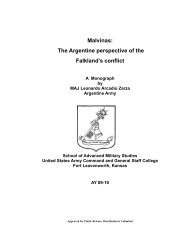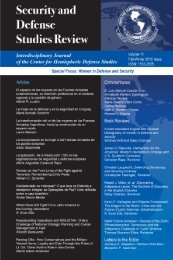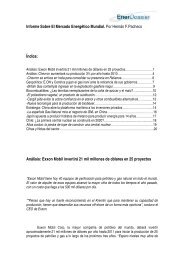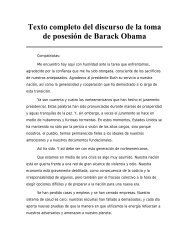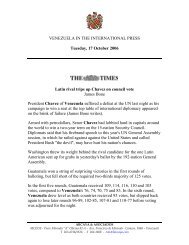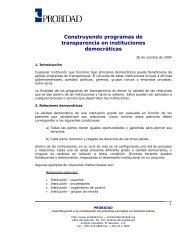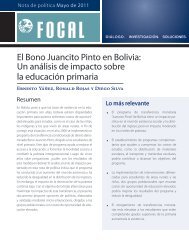was prepared by the Office of the Chief of Chaplains <strong>and</strong> administered by Army chaplains. Itsintertwined curriculum included religion, citizenship <strong>and</strong> character building, with a series of lecturesre<strong>info</strong>rcing the idea that the country’s leadership <strong>and</strong> service in the armed forces reflected God’s will<strong>and</strong> that atheistic totalitarian ideologies abroad represented a fundamental threat to the United States.“Religion in Our Way of Life” offered the counsel that “service to the nation is most effective onlywhen religion becomes part of individual life.” The lecture “The Nation We Serve” called the UnitedStates a “covenant nation” recognizing “its dependence upon God <strong>and</strong> its responsibility toward God,”in which “public institutions <strong>and</strong> official thinking reflect a faith in the existence <strong>and</strong> the importance ofdivine providence.” Another, “Our Moral <strong>Defense</strong>s,” stressed the importance of developing “a desireto live in accordance with moral principles as the best defense against the aggression of a totalitarianphilosophy.” 69The Character Guidance initiative came as the Army also worried about an increasing incidentrate of venereal disease among the troops, with Secretary of War Robert Patterson specificallyreferencing the public health problem, saying it was “higher than at any time in the past thirty years,”in his announcement of the character education initiative to the Army Chief of Chaplains. 70 TheOffice, Chief of Chaplains helped rewrite Army policy on the issue, which resulted in a new directiveon “Discipline <strong>and</strong> Venereal Disease.” As part of this new directive, chaplains were tasked withdelivering “Citizenship-Morality Lectures” prepared by the chaplains’ office. Reportedly, once thenew policy was implemented, “VD rates went down, <strong>and</strong> attitudes <strong>and</strong> moral improved.” 71Anne C. Lovel<strong>and</strong> explains that the requirements for a st<strong>and</strong>ing army in a time of peace, <strong>and</strong>concern about the possible “corrupting aspects of the military environment” placed a premiumon military services’ ability to show that soldiers would be returned to civilian life “in the bestpossible physical, mental, moral, <strong>and</strong> spiritual condition,” particularly with the return of peacetimeconscription in 1948. As a result of having included moral <strong>and</strong> civic as well as religious instructioninto regular training, “Army leaders were able to offer assurance that their character-buildingprograms would return soldiers to civilian society as virtuous, God-fearing, democratic citizens.” 72Chaplains’ interest in the Character Guidance program was motivated in part by the temporalrewards of corporate interest, the “preoccupation with national preparedness <strong>and</strong> total mobilization”in the chilliest climes of the Cold War presenting “a momentous opportunity for Army chaplains,”Lovel<strong>and</strong> wrote. “Traditionally, their involvement in military training had been limited to lectureson sexual morality.Perhaps inspired by the appreciation high-ranking military leaders accorded them duringWorld War II, in the immediate postwar period they campaigned for a more central role.…(i)t is clear that chaplains regarded it as a means of raising their status <strong>and</strong> exp<strong>and</strong>ingtheir influence. … (W)riting about the newly-established Character Guidance program Chiefof Chaplains Miller observed: “The Army chaplain is no longer playing guard; he is in thebackfield. Comm<strong>and</strong>ing officers more <strong>and</strong> more are making up plays with the chaplaincarrying the ball.” 73The Character Guidance Program faithfully reflected U.S. military values <strong>and</strong> strategies. It was,Waldo W. Burchard said, “a direct attempt on the part of chaplains to ‘sell’ military life to servicemen. … The lectures are ‘canned.’ They are prepared by a special Board of chaplains, <strong>and</strong> prior tobeing distributed to chaplains in the field, they are approved <strong>and</strong> pronounced official state policy bythe Secretary of <strong>Defense</strong>.” 7470Patterson quoted in Venzke, Confidence in Battle, Inspiration in Peace: The United States Army Chaplaincy, 1945-1975 (Washington: Office of theChief of Chaplains, Department of the Army, 1977), p. 41.71Letter to Rev. Paul Tanner from Chaplain Harold O. Prudell, Headquarters Chaplain School, Carlisle Barracks, Pa., December 15, 1947, Box 57,Folder: “Military Affairs: Chaplains, 1945-1950;” ACUA.72Lovel<strong>and</strong>, “Character Education in the U.S. Army, 1847-1977,” op. cit., p. 801.73Lovel<strong>and</strong>, “Character Education in the U.S. Army, 1847-1977,” op. cit., p. 804.74Burchard, op. cit., p. 535.130<strong>Security</strong> <strong>and</strong> <strong>Defense</strong> <strong>Studies</strong> <strong>Review</strong> 2009/Edición 2009/ Edicão 2009/ Volume 9, Issues 1 & 2
The program’s reduction <strong>and</strong> eventual demise reflected a lessening of fears of “godlesscommunism,” new theories of military sociologists that added to military comm<strong>and</strong>ers’ skepticismof the importance of moral <strong>and</strong> spiritual instruction to combat motivation, <strong>and</strong> “an increasingsecularization of the public sphere” in which arguments for church-state separation once again roseto the fore. By 1963, the Army Chaplains Office had to reiterate to the chaplain-instructors that theprogram was “non-religious” <strong>and</strong> should not be confused with or used for religious instruction. Sixyears later, a new set of guidelines were issued that clearly set the chaplains task outside the religiousdomain, saying that they must “recognize fully that their role in the Character Guidance Program isstrictly as a staff officer performing a military function.” With the switch to an all-volunteer Army,which did not need public support for a selective service system, the service “sidelined a programdesigned to inculcate personal <strong>and</strong> civic values in an army of citizen-soldiers, relying instead on arevitalized military ethic to teach the values <strong>and</strong> behavior appropriate to professional soldiers.” 75Termination of the chaplain-run program also spelled the end of perhaps the most ambitious strategiccommunications effort ever undertaken by the chaplains’ corps, one that counted on “a defensiblepolicy, a respectable identity, a core value” for its inspiration <strong>and</strong> success.ConclusionMilitary chaplains have conducted the classic tasks of strategic communications—those involvinggoal setting, situational knowledge, communication competence, <strong>and</strong> anxiety management—in avariety of situations of peace <strong>and</strong> war throughout history. The development of armed forces’ quasiindependentreligious corps has at times lent crucial role support, both within the services <strong>and</strong> in thecommunity at large, for the political orientation <strong>and</strong> strategic direction—including ideas, policies <strong>and</strong>courses of action—of the military <strong>and</strong> its political overseers.The historical record of chaplains as strategic communicators offers a new perspective on howthey were able to maintain the respectable identities <strong>and</strong> core values as military officers <strong>and</strong> as leadersof a spiritual community. It is no accident that in non-religious states, political officers or one-partystate commissars have had to fill the void in areas of morale, motivation <strong>and</strong> political socialization.Since the end of the 19 th century, there have been several instances where military chaplainshave played key roles in post-conflict scenarios such as peacekeeping <strong>and</strong> stability operations. Inthe Spanish-American War, Army Gen. John J. Pershing’s chaplain worked as a liaison with bothCatholic clergy <strong>and</strong> Muslim leaders in the Philippines to reduce hostilities. A military chaplain’sreligious support to former Nazi war criminals on trial at Nuremberg created a “unique trust” that“facilitated increased cooperation of criminals with authorities.” In turn, the “symbolic <strong>and</strong> actualsuccess of these trials was crucial to the stability <strong>and</strong> reconstruction of post-war Europe.” Morerecently, military chaplains have also established trust relationships with local communities in SaudiArabia during Operations Desert Shield <strong>and</strong> Desert Storm, was well as during stability operations inthe Balkans conflict. During Operation Iraqi Freedom, an army chaplain’s outreach to local Muslimclerics resulted in a “measurable decrease” in violence against U.S. troops. “(C)haplains have beendrawn on by visionary comm<strong>and</strong>ers to connect with indigenous religious leaders <strong>and</strong> communitiesto increase success <strong>and</strong> reduce risks in stability operations,” the authors of a recent study on militarychaplains as “peace builders” noted. “Religion is best viewed as a force useful in stability operationsrather than an issue to disregard or overcome.” 76Appreciation of the military chaplains’ historic role as strategic communicators can be animportant step in the realization of these <strong>and</strong> other national strategic goals, such as combatingterrorism or carrying out successful peacekeeping missions.75Lovel<strong>and</strong>, “Character Education in the U.S. Army, 1847-1977,” op. cit., pp. 805-810, 818.76On the Nuremberg example, see William J. Hourihan, “U.S. Army Chaplain Ministry to German War Criminals at Nuremberg, 1945-1946,” in Col.(Ret.) Walter J. Boyne, Today’s Best Military Writing. The Finest Articles on the Past, Present, <strong>and</strong> Future of the U.S. Military,” (New York: ForgeBooks, 2005); Chaplain William Sean Lee, et. al., Military Chaplains as Peace Builders, op. cit., pp. 7, 15-16.<strong>Security</strong> <strong>and</strong> <strong>Defense</strong> <strong>Studies</strong> <strong>Review</strong> 2009/Edición 2009/ Edicão 2009/ Volume 9, Issues 1 & 2 131
- Page 4 and 5:
Document: Speech on “Security, In
- Page 6 and 7:
6Security and Defense Studies Revie
- Page 8 and 9:
un tema de seguridad y defensa porq
- Page 10 and 11:
Los Intereses de la República Popu
- Page 12 and 13:
En el marco estratégico descrito e
- Page 14 and 15:
Works (FAW), Geeley, Dongfeng, y Ch
- Page 16 and 17:
interés en participar en el yacimi
- Page 18 and 19:
al emplear personas locales en todo
- Page 20 and 21:
había un banco en Colombia especia
- Page 22 and 23:
ehén de los FARC, escribe de siete
- Page 24 and 25:
estadounidenses en el futuro, y por
- Page 26 and 27:
26Security and Defense Studies Revi
- Page 28 and 29:
Existe numerosa literatura que trat
- Page 30 and 31:
La Tabla 1.1, demuestra que el apor
- Page 32:
Los cuestionamiento a este modelo d
- Page 35 and 36:
….derogaremos la Ley del Cobre y
- Page 37 and 38:
Figura 4.3.Aporte de CODELCO por ve
- Page 39:
Figura 6.Elaboración propia distri
- Page 42 and 43:
de los proyectos de defensa necesit
- Page 44 and 45:
En el caso de las inversiones en de
- Page 46 and 47:
Anexo 1PROTOCOLO DE ACUERDO QUE ACO
- Page 48 and 49:
OECD. “Models of Public Budgeting
- Page 50 and 51:
proyectos nacionales y democrático
- Page 52 and 53:
DesprofesionalizaciónEn la región
- Page 54 and 55:
Según algunos autores, “no sorpr
- Page 56 and 57:
(antinarcóticos), la Guardia Coste
- Page 58 and 59:
supervigilen las acciones intrusiva
- Page 60 and 61:
Quizás una de las fallas provenga
- Page 62 and 63:
Junto con ello se elaboró una nuev
- Page 64 and 65:
Colombia). Por otro, hay una serie
- Page 66 and 67:
Maldonado, Carlos, “Profesionalis
- Page 68 and 69:
policías y militares no ha estado
- Page 70:
La relación entre fuerzas militare
- Page 73 and 74:
dictaduras. En aquellos con más tr
- Page 75 and 76:
efectos de planificación se ha hab
- Page 77 and 78:
BibliografíaAguila, Ernesto y Mald
- Page 79 and 80: Sherman, Lawrence. et.al. 1973. Tea
- Page 81: Influenza Pandemic and its National
- Page 84 and 85: and restaurant services” is expec
- Page 86 and 87: The ability of the health sector to
- Page 88 and 89: BibliographyAlmond, D. and B. Mazum
- Page 90 and 91: El trabajo parte del supuesto de qu
- Page 92 and 93: es tanto una elección voluntaria c
- Page 94 and 95: Por otro lado, Rusia nunca ha visto
- Page 96 and 97: La Organización del Tratado del At
- Page 98 and 99: liquidez internacional pero tambié
- Page 100 and 101: petróleo recientemente descubierta
- Page 102 and 103: Dentro de este esquema, Estados Uni
- Page 104 and 105: 104Security and Defense Studies Rev
- Page 106 and 107: minimize a number of attempts at fo
- Page 108 and 109: kidnapping, of Maria Edith de Deber
- Page 110 and 111: The political campaign that resulte
- Page 112 and 113: would carry out the more violent ta
- Page 114 and 115: of the EPP so far, is the relative
- Page 117 and 118: to accept ideas, policies or course
- Page 119 and 120: eing killed themselves—the idea t
- Page 122 and 123: In Latin America, the role played b
- Page 124 and 125: the Church to be given to the dying
- Page 126 and 127: from providing military chaplains t
- Page 128 and 129: Perhaps one of the clearest example
- Page 132 and 133: 132Security and Defense Studies Rev
- Page 135 and 136: Keynote Speech by Dr. Frank O. Mora
- Page 137 and 138: If successful, these infrastructure
- Page 139 and 140: Security, Intelligence and the Role
- Page 141 and 142: Clearly, security, intelligence and
- Page 143 and 144: Contratapa(Contratapa offers, in a
- Page 145 and 146: efforts have become intertwined; fo
- Page 147 and 148: comprensión de sus valores y cultu



